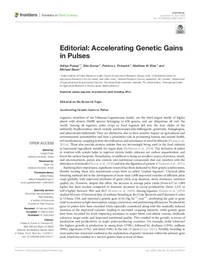Editorial: Accelerating Genetic Gains in Pulses

Authors:
Legumes, members of the Fabaceae/Leguminosae family, are the third largest family of higher
plants with almost 20,000 species belonging to 650 genera, and are ubiquitous all over the
world. Among all legumes, pulse crops or food legumes fall into the four clades of the
subfamily Papilionoideae which include aeschynomenoids/dalbergiods, genistoids, hologalegina,
and phaseoloids/millettoids. They are distinctive due to their positive impact on agricultural and
environmental sustainability and have a prominent role in promoting human and animal health,
soil amelioration, cropping system diversification, and sustenance of rural livelihoods (Pratap et al.,
2021a). These also provide protein isolates that are increasingly being used in the food industry
as functional ingredients suitable for vegan diets (Robinson et al., 2019). The inclusion of pulses
in rotation with cereals helps to improve system yields, enhance net carbon sequestration, and
lower the carbon footprint. Nonetheless, in addition to being an excellent source of protein, starch,
and micronutrients, pulses also contain anti-nutritional compounds that can interfere with the
absorption of minerals (Moore et al., 2018) and also the digestion of protein (Clemente et al., 2015).
Realizing their importance, significant research has been dedicated to their genetic amelioration,
thereby turning them into mainstream crops from so-called “orphan legumes”. Classical plant
breeding methods led to the development of more than 3,800 improved varieties of different pulse
crops globally, with improved attributes of grain yield, crop duration, stress resistance, nutrition
quality, etc. However, despite this effort, the increase in average pulse yields (from 637 to 1,009
kg/ha) has been modest compared to dramatic increases in cereal productivity (from 1,353 to
4,074 kg/ha) between 1961 and 2017 (Kumar et al., 2020). Among legumes, Koester et al. (2014)
studied 80 years of historical data of soybean breeding at the Crop Research and Education Center
in Urbana, USA and reported a genetic gain of 26.5 kg ha−1
year−1
, attributing the gain in grain
yield to increases in light interception, energy conversion, and partitioning efficiencies. Productivity
gains in pulses have been recorded when especially considered along with the markedly reduced
duration of the improved varieties, leading to increased cropping intensity, while genetic gains
have been recorded for traits imparting resistance to major biotic and abiotic stresses, herbicide
tolerance, larger seeds, and improved nutritional quality. This resulted in the growth, in terms of
production and productivity, in major pulse-producing countries. For example, India witnessed
the highest growth in production in mung bean (178%), followed by chickpea (125%), urdbean
(90%), pigeonpea (51%), and lentil (34%) in the last 15 years (Gaur, 2021). Notably, breeding in
most pulses has remained confined to the exploitation of genetic variation within the primary gene
pool, which has resulted in a narrow genetic base in most of them.
